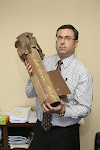It’s a safe bet that King David of biblical fame never set foot in the Tower of David. That’s because the foundations for the citadel that everyone calls the Tower of David were first laid by the Hasmonean (Maccabee) rulers of Israel over 2,000 years ago when they were building a wall around Jerusalem – nearly a millennia after King David passed into the next life. And the minaret jutting high above the citadel – at times also known as the Tower of David — only dates back a few centuries.
The citadel has had a rich and varied history. King Herod constructed a palace next to the Hasmonean city wall and added three towers to defend this side of Jerusalem. Mariam Tower was 22.5 meters high and named for his favorite and beloved wife (whom he later murdered); A second, at 40 meters, was called Hippicus for a friend of Herod’s who fell in battle. The tallest was Phasael Tower, named for one of Herod’s brothers.
During the Great Revolt of 66 C.E., Jewish defenders holed up in the citadel when put to rout by the Romans. After the fall of Jerusalem in 70 C.E., Titus destroyed the towers and stationed the soldiers of the Tenth Roman Legion at the site. In the 14th century, the Mamelukes ruling Israel at the time built the contemporary fortress – adding a mosque so that the troops could worship without leaving the area unguarded.
‘During the Byzantine era Christian pilgrims whose eyes fell on the base of the tower believed that the great Jewish monarch was responsible for its construction.’
So if King David had absolutely nothing to do with his illustrious namesake, why do we call it the Tower of David? Still standing to this day, the base of Phasael Tower was impressive. During the Byzantine era (4-7th centuries) Christian pilgrims whose eyes fell on the base of the tower believed that the great Jewish monarch was responsible for its construction. Muslims continued the tradition by fashioning a prayer-site over the spot where they believed David had stopped to pray and naming it for the King. Crusader maps mark the remnants as “David’s Tower. Finally, in the 19th century, travelers erroneously referred to the minaret as the Tower of David and the name caught on.
During the War of Independence, the Old City fell into Jordanian hands. Jaffa Gate was blocked and the fortress became a Jordanian army post. But with the re-unification of Jerusalem, the citadel fell into Israeli hands. Today it houses an unforgettable enterprise: the Tower of David Museum of the History of Jerusalem. Suitably located at the gateway to the Old City, this is the only museum in the world that deals exclusively with the history of Jerusalem.
The Tower of David Museum spans the colorful millennia of the city’s history with a light, instructive and unusual touch. Not only do lively and exciting displays utilize holograms, laser projections, animation, models and dioramas, but the museum buildings and grounds are also historical sites just waiting to be explored.
My favorite of three suggested tours leads you chronologically through Jerusalem’s history. It begins with the Canaanite period and moves through the First and Second Temple eras and ends with the Six-Day War. I find especially moving a multi-media presentation which closes with the establishment of the State of Israel.
A second tour sends you from one breathtaking observation point to another for panoramic views of the city. If you take the third route you visit an archeological garden, whose remains span from the Hasmonean period to the Turkish era. Free guided tours are available in English with your entrance to the museum.
As if the museum and its fantastic exhibits weren’t enough for Jerusalem’s visitors, the museum also presents a fabulous multi-media show aptly named the Night Spectacular. Viewed from the archaeological garden, the production offers an incredible insight into the mysterious, vast, colorful history of the most exciting city in the world.
As if the museum and its fantastic exhibits weren’t enough for Jerusalem’s visitors, the museum also presents a fabulous multi-media show aptly named the Night Spectacular. Viewed from the archaeological garden, the production offers an incredible insight into the mysterious, vast, colorful history of the most exciting city in the world.
In addition to night programs in the archaeological garden, the Tower of David Museum also presents wonderful, atmospheric concerts. The upcoming offering, on September 4, is special, for this year the museum’s annual Cantorial Concert honors the prolific composer of liturgical music and one of the most talented cantors of all time: Russian-born Yossele Rosenblatt, who died in Jerusalem in 1933 at the age of 51.
The program of Sabbath songs and well-known liturgies such as Shalom Alechem, Tzur Yisrael and Yismechu will be presented by seven different cantors to music either composed by Yossele Rosenblatt or adapted and sung by him on different occasions. For details see www.towerofdavid.org.il.
Aviva Bar-Am is the author of seven guides to Israel. Shmuel Bar-Am is a private tour guide.
All rights reserved.

